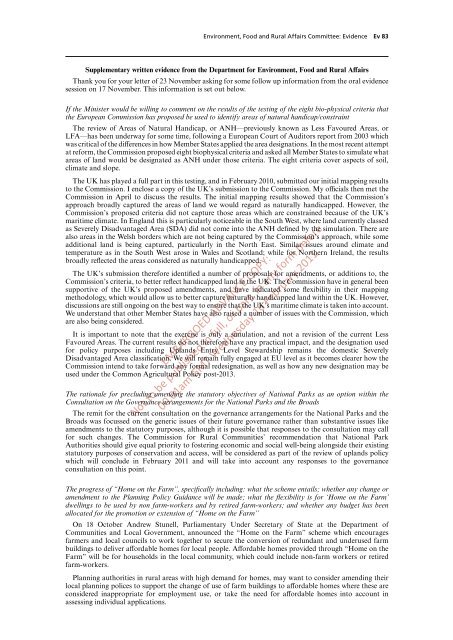Farming in the Uplands - ARCHIVE: Defra
Farming in the Uplands - ARCHIVE: Defra
Farming in the Uplands - ARCHIVE: Defra
Create successful ePaper yourself
Turn your PDF publications into a flip-book with our unique Google optimized e-Paper software.
Environment, Food and Rural Affairs Committee: Evidence Ev 83<br />
Supplementary written evidence from <strong>the</strong> Department for Environment, Food and Rural AVairs<br />
Thank you for your letter of 23 November ask<strong>in</strong>g for some follow up <strong>in</strong>formation from <strong>the</strong> oral evidence<br />
session on 17 November. This <strong>in</strong>formation is set out below.<br />
If <strong>the</strong> M<strong>in</strong>ister would be will<strong>in</strong>g to comment on <strong>the</strong> results of <strong>the</strong> test<strong>in</strong>g of <strong>the</strong> eight bio-physical criteria that<br />
<strong>the</strong> European Commission has proposed be used to identify areas of natural handicap/constra<strong>in</strong>t<br />
The review of Areas of Natural Handicap, or ANH—previously known as Less Favoured Areas, or<br />
LFA—has been underway for some time, follow<strong>in</strong>g a European Court of Auditors report from 2003 which<br />
was critical of <strong>the</strong> diVerences <strong>in</strong> how Member States applied <strong>the</strong> area designations. In <strong>the</strong> most recent attempt<br />
at reform, <strong>the</strong> Commission proposed eight biophysical criteria and asked all Member States to simulate what<br />
areas of land would be designated as ANH under those criteria. The eight criteria cover aspects of soil,<br />
climate and slope.<br />
The UK has played a full part <strong>in</strong> this test<strong>in</strong>g, and <strong>in</strong> February 2010, submitted our <strong>in</strong>itial mapp<strong>in</strong>g results<br />
to <strong>the</strong> Commission. I enclose a copy of <strong>the</strong> UK’s submission to <strong>the</strong> Commission. My oYcials <strong>the</strong>n met <strong>the</strong><br />
Commission <strong>in</strong> April to discuss <strong>the</strong> results. The <strong>in</strong>itial mapp<strong>in</strong>g results showed that <strong>the</strong> Commission’s<br />
approach broadly captured <strong>the</strong> areas of land we would regard as naturally handicapped. However, <strong>the</strong><br />
Commission’s proposed criteria did not capture those areas which are constra<strong>in</strong>ed because of <strong>the</strong> UK’s<br />
maritime climate. In England this is particularly noticeable <strong>in</strong> <strong>the</strong> South West, where land currently classed<br />
as Severely Disadvantaged Area (SDA) did not come <strong>in</strong>to <strong>the</strong> ANH def<strong>in</strong>ed by <strong>the</strong> simulation. There are<br />
also areas <strong>in</strong> <strong>the</strong> Welsh borders which are not be<strong>in</strong>g captured by <strong>the</strong> Commission’s approach, while some<br />
additional land is be<strong>in</strong>g captured, particularly <strong>in</strong> <strong>the</strong> North East. Similar issues around climate and<br />
temperature as <strong>in</strong> <strong>the</strong> South West arose <strong>in</strong> Wales and Scotland; while for Nor<strong>the</strong>rn Ireland, <strong>the</strong> results<br />
broadly reflected <strong>the</strong> areas considered as naturally handicapped.<br />
The UK’s submission <strong>the</strong>refore identified a number of proposals for amendments, or additions to, <strong>the</strong><br />
Commission’s criteria, to better reflect handicapped land <strong>in</strong> <strong>the</strong> UK. The Commission have <strong>in</strong> general been<br />
supportive of <strong>the</strong> UK’s proposed amendments, and have <strong>in</strong>dicated some flexibility <strong>in</strong> <strong>the</strong>ir mapp<strong>in</strong>g<br />
methodology, which would allow us to better capture naturally handicapped land with<strong>in</strong> <strong>the</strong> UK. However,<br />
discussions are still ongo<strong>in</strong>g on <strong>the</strong> best way to ensure that <strong>the</strong> UK’s maritime climate is taken <strong>in</strong>to account.<br />
We understand that o<strong>the</strong>r Member States have also raised a number of issues with <strong>the</strong> Commission, which<br />
are also be<strong>in</strong>g considered.<br />
It is important to note that <strong>the</strong> exercise is only a simulation, and not a revision of <strong>the</strong> current Less<br />
Favoured Areas. The current results do not <strong>the</strong>refore have any practical impact, and <strong>the</strong> designation used<br />
for policy purposes <strong>in</strong>clud<strong>in</strong>g <strong>Uplands</strong> Entry Level Stewardship rema<strong>in</strong>s <strong>the</strong> domestic Severely<br />
Disadvantaged Area classification. We will rema<strong>in</strong> fully engaged at EU level as it becomes clearer how <strong>the</strong><br />
Commission <strong>in</strong>tend to take forward any formal redesignation, as well as how any new designation may be<br />
used under <strong>the</strong> Common Agricultural Policy post-2013.<br />
The rationale for preclud<strong>in</strong>g amend<strong>in</strong>g <strong>the</strong> statutory objectives of National Parks as an option with<strong>in</strong> <strong>the</strong><br />
Consultation on <strong>the</strong> Governance arrangements for <strong>the</strong> National Parks and <strong>the</strong> Broads<br />
The remit for <strong>the</strong> current consultation on <strong>the</strong> governance arrangements for <strong>the</strong> National Parks and <strong>the</strong><br />
Broads was focussed on <strong>the</strong> generic issues of <strong>the</strong>ir future governance ra<strong>the</strong>r than substantive issues like<br />
amendments to <strong>the</strong> statutory purposes, although it is possible that responses to <strong>the</strong> consultation may call<br />
for such changes. The Commission for Rural Communities’ recommendation that National Park<br />
Authorities should give equal priority to foster<strong>in</strong>g economic and social well-be<strong>in</strong>g alongside <strong>the</strong>ir exist<strong>in</strong>g<br />
statutory purposes of conservation and access, will be considered as part of <strong>the</strong> review of uplands policy<br />
which will conclude <strong>in</strong> February 2011 and will take <strong>in</strong>to account any responses to <strong>the</strong> governance<br />
consultation on this po<strong>in</strong>t.<br />
EMBARGOED ADVANCE COPY:<br />
Not to be published <strong>in</strong> full, or part, <strong>in</strong> any form before<br />
00.01am GMT Wednesday 16 February 2011<br />
The progress of “Home on <strong>the</strong> Farm”, specifically <strong>in</strong>clud<strong>in</strong>g: what <strong>the</strong> scheme entails; whe<strong>the</strong>r any change or<br />
amendment to <strong>the</strong> Plann<strong>in</strong>g Policy Guidance will be made; what <strong>the</strong> flexibility is for ‘Home on <strong>the</strong> Farm’<br />
dwell<strong>in</strong>gs to be used by non farm-workers and by retired farm-workers; and whe<strong>the</strong>r any budget has been<br />
allocated for <strong>the</strong> promotion or extension of “Home on <strong>the</strong> Farm”<br />
On 18 October Andrew Stunell, Parliamentary Under Secretary of State at <strong>the</strong> Department of<br />
Communities and Local Government, announced <strong>the</strong> “Home on <strong>the</strong> Farm” scheme which encourages<br />
farmers and local councils to work toge<strong>the</strong>r to secure <strong>the</strong> conversion of redundant and underused farm<br />
build<strong>in</strong>gs to deliver aVordable homes for local people. AVordable homes provided through “Home on <strong>the</strong><br />
Farm” will be for households <strong>in</strong> <strong>the</strong> local community, which could <strong>in</strong>clude non-farm workers or retired<br />
farm-workers.<br />
Plann<strong>in</strong>g authorities <strong>in</strong> rural areas with high demand for homes, may want to consider amend<strong>in</strong>g <strong>the</strong>ir<br />
local plann<strong>in</strong>g polices to support <strong>the</strong> change of use of farm build<strong>in</strong>gs to aVordable homes where <strong>the</strong>se are<br />
considered <strong>in</strong>appropriate for employment use, or take <strong>the</strong> need for aVordable homes <strong>in</strong>to account <strong>in</strong><br />
assess<strong>in</strong>g <strong>in</strong>dividual applications.

















